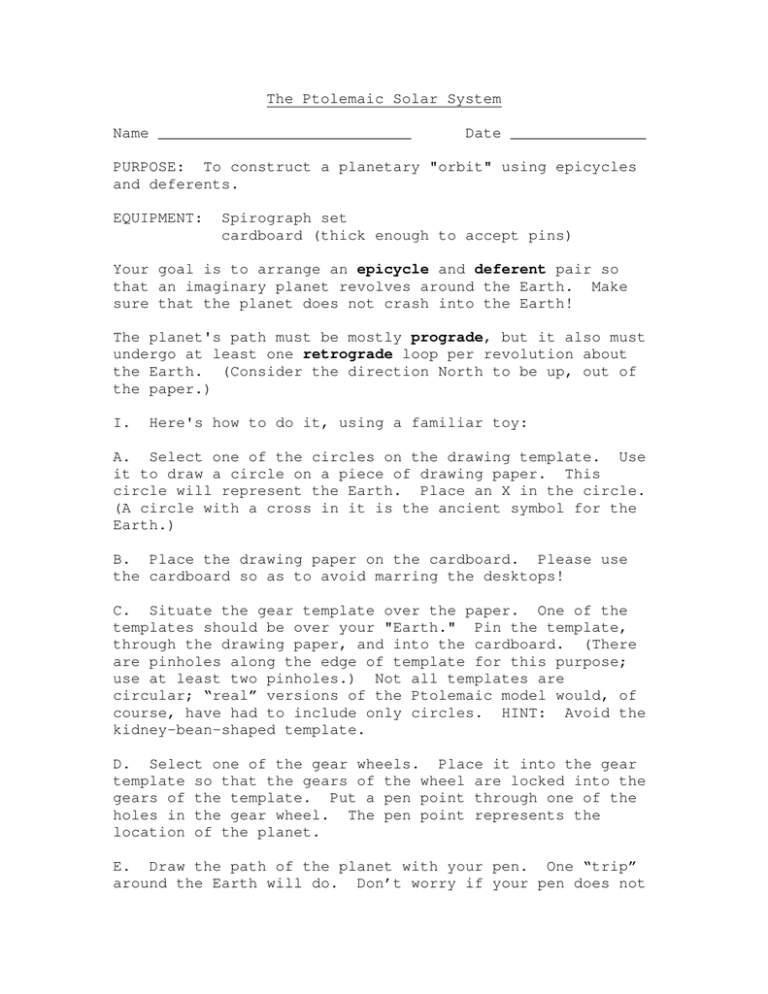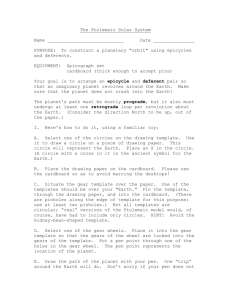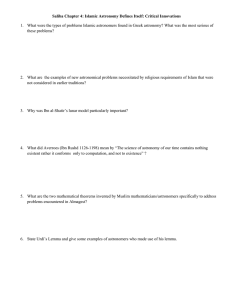The Ptolemaic Solar System
advertisement

The Ptolemaic Solar System Name ____________________________ Date _______________ PURPOSE: To construct a planetary "orbit" using epicycles and deferents. EQUIPMENT: Spirograph set cardboard (thick enough to accept pins) Your goal is to arrange an epicycle and deferent pair so that an imaginary planet revolves around the Earth. Make sure that the planet does not crash into the Earth! The planet's path must be mostly prograde, but it also must undergo at least one retrograde loop per revolution about the Earth. (Consider the direction North to be up, out of the paper.) I. Here's how to do it, using a familiar toy: A. Select one of the circles on the drawing template. Use it to draw a circle on a piece of drawing paper. This circle will represent the Earth. Place an X in the circle. (A circle with a cross in it is the ancient symbol for the Earth.) B. Place the drawing paper on the cardboard. Please use the cardboard so as to avoid marring the desktops! C. Situate the gear template over the paper. One of the templates should be over your "Earth." Pin the template, through the drawing paper, and into the cardboard. (There are pinholes along the edge of template for this purpose; use at least two pinholes.) Not all templates are circular; “real” versions of the Ptolemaic model would, of course, have had to include only circles. HINT: Avoid the kidney-bean-shaped template. D. Select one of the gear wheels. Place it into the gear template so that the gears of the wheel are locked into the gears of the template. Put a pen point through one of the holes in the gear wheel. The pen point represents the location of the planet. E. Draw the path of the planet with your pen. One “trip” around the Earth will do. Don’t worry if your pen does not return exactly to its starting place. the “planet” traveled with an arrow. Label the direction Answer the questions on this page. Remember to make all observations with respect to the center of the Earth--just as the Ancients did. 1. Which gear template did you use? (Describe it.) 2. Which gear wheel did you use? (Each gear wheel has a unique number printed on it, in large print.) 3. Which pen hole did you use? (Each pen hole has a unique number printed next to it, in small print.) 4. Which device represents the epicycle? 5. Which device represents the deferent? 6. How many retrograde loops did you produce per revolution? (Recall, of course, that a real planet only undergoes one such loop per trip around the sky.) 7. What are you doing to the epicycle/deferent when you choose a higher number pinhole? 8. Assuming that both the epicycle and deferent undergo uniform circular motion, for approximately how much time (as a fraction of the orbital period) is the planet moving retrograde? 9. This Ptolemaic model is constrained in a way the “real” epicycles and deferents were not. How do the gears constrain this Ptolemaic model? 10. You have constructed a __________centric model of the Solar System. Attach your final drawing to this lab sheet and turn in both. Notice that there is more than one "correct" answer! Your drawing may not look like that of your neighbor . . .




